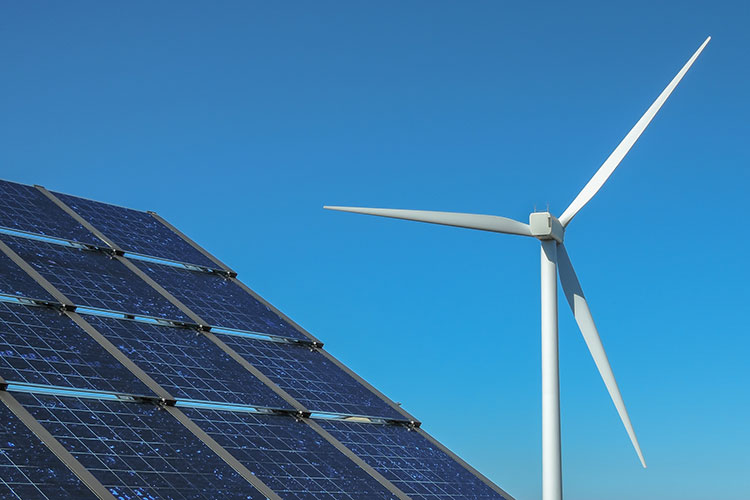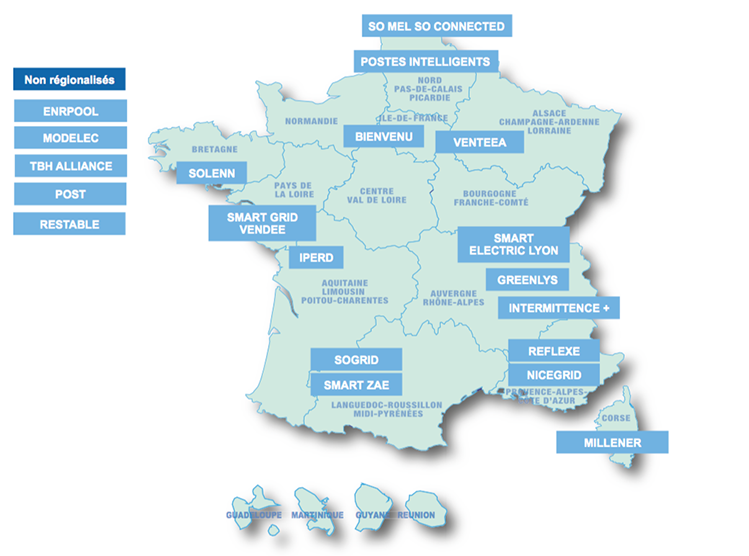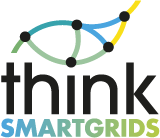Ademe recently published a report on the Smart Grid demonstrators that it had supported as part of the Investissements d’Avenir (Investments of the Future) programme. Energy management, integrating decentralized renewable production, anticipating the evolution of existing networks, prefiguring new business models … On each of these issues, the lessons are positive and “make it possible to envisage New advances and a wider deployment “.
 Solar panels and a windmill – Photo credit: Ed Suominen in CC
Solar panels and a windmill – Photo credit: Ed Suominen in CC
Ademe has supported 20 demonstration projects since 2009. Last October, it released an initial report on the returns of the 12 most advanced projects.
The objective of these projects was to validate technically and test in real conditions the solutions in order to identify the levers of a successful deployment. It was also a question of lifting technological, economic and / or social locks around four themes:
- Promote demand management and energy management actions.
- Facilitate the integration of decentralized renewable production.
- Anticipate the evolution of existing networks.
- Prefigure Smart Grids business models.
This assessment was carried out by means of a questionnaire to the project promoters.

The 20 projects funded by ADEME in the frame of PIA – ADEME 2016
Demand Control: Towards an Energy Culture among consumers
One of the challenges of the demonstrators was to call upon consumer intelligence by providing them with information on their electricity consumption, the first step towards an “energy culture”.
It is clear from this assessment that energy savings resulting from consumer data range from 1 to 10% depending on the aims of the device in place. Consumer information is more effective and sustainable if the latter is “accompanied and advised”.
Thus, “the notion of called power, and the constraints it can generate on the network during peak consumption, for example, is still little known among consumers, in the residential and tertiary sectors. This has the effect of rendering less comprehensible, the demand management (or peak shaving) functionality, which is generally confused with the Energy Demand Control (EDC), which concerns the more global decrease in energy consumption “.
Ademe observes that “demand management solutions are all the more acceptable to consumers if they combine EDC functionalities (displays, comparison …). To this end, Ademe adds that “possible future calls for tenders for the development of peak shaving in the residential sector should include an obligation to inform / sensitize consumers on the consumption of electricity in order to promote EDC and the cost-effectiveness of erasure facilities “.
Concerning diffuse peak shaving, “the first results of the projects show that the deferral of consumption is in theory of 100% of consumption shaved if there is no loss of comfort”. In practice, the carry-over is generally between 40% and 70% for heating due to better use of external heat inputs or a reduction in the temperature inside the building. The shavable power source per household would thus be about 1 kW, due to the abundance of uses inside the dwelling.
According to Ademe, the maintenance and emergence of active peak shaving operators also on the balancing market “will help meet the greater needs in terms of adjustment in the coming years. Indeed, as an example, from 2020, the forecasting error on wind could become higher than that of demand.
Integration of Renewables: towards the storage of energy
It emerges from the studied projects that “technologies such as production clipping (limitation of the power injected on the network), improvement of knowledge of the local state of the network (observability of the distribution network) and modernization Of the voltage regulation (fine tuning of the voltage), should allow a significant increase in the connectable energies “.
Consequently, according to Ademe, “a regulatory framework should be put in place to economically use the production siding produced by the Renewable Energies producers”.
In addition, storage can take place at different levels, in multiservice mode with the transmission network, the distribution network, the producers of renewable energy or the consumer. By its flexibility, it therefore favors the insertion of renewable energies.
“In view of the current conditions (notably the price in the electricity market), Ademe adds, no project has at this stage enabled the emergence of an obvious business model for a storage medium in the” For immediate implementation. The question of the valorization of the storage facility and the creation of a storage operator status is therefore essential to its development, since storage is at the crossroads as a brick of flexibility “.
Evolution of networks: validation of technological bricks before deployment
The projects have led to validation of the industrialization capacity and mature nature of several technological bricks to modernize the networks: the mini Digital Control Station, various types of voltage and current sensors used for the measurement or detection of faults, controlled load adjustable transformers for fine tuning network voltage levels, automated circuit breakers and large storage systems (around MW).
In addition, information systems that take local real-time network status into account locally and integrate new devices into management, information exchange and network manager planning tools should be able to manage Networks “more dynamically, closer to the limits of the system”.
In the deployment planning, Ademe believes that “some centralized stationary storage technologies may require the production of a Classified Installation for Environmental Protection (ICPE)”.
Business models: locks to be lifted to ensure the deployment of Smart Grids
The projects helped “to clarify the economic and regulatory conditions necessary for the deployment of smart grids”.
As regards the regulated activity of network operators, which carry out a public service mission, Ademe believes that “technologies will be able to deploy once they are able to demonstrate their benefits to the community and their industrial character. Since the requirements of maturity and reliability of the technologies are important from the point of view of the network operators for reasons of obligation of quality of service “.
For the deregulated sector, which is open to competition, notably downstream, “conditions of deployment are much more difficult to define, with quite different scenarios depending on the solutions considered and still many uncertainties related in particular to the Economic valuation of solutions “.
In the short term, however, Ademe concludes that “many products or services developed within the framework of demonstrators should nevertheless find a market in line with the evolutions of the regulatory framework discussed in recent years and whose implementation is or is about to begin”.
ITEMS International for Think Smartgrids
Sources : Rapport Systèmes Electriques Intelligents : premiers résultats des démonstrateurs



